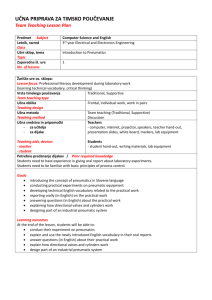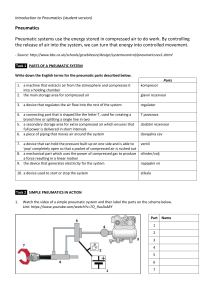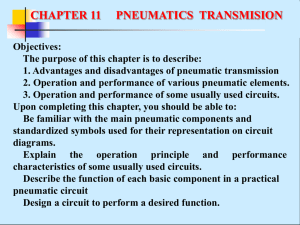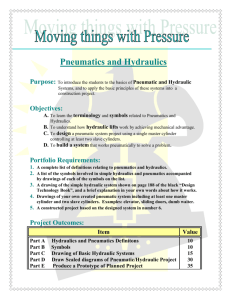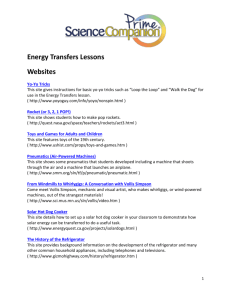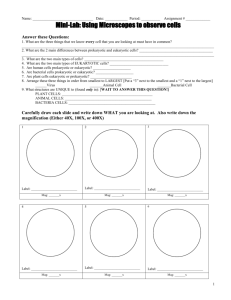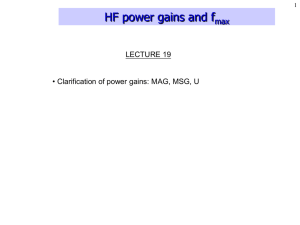WashTec A Clean Car Every Minute Interview Dr. Huu
advertisement
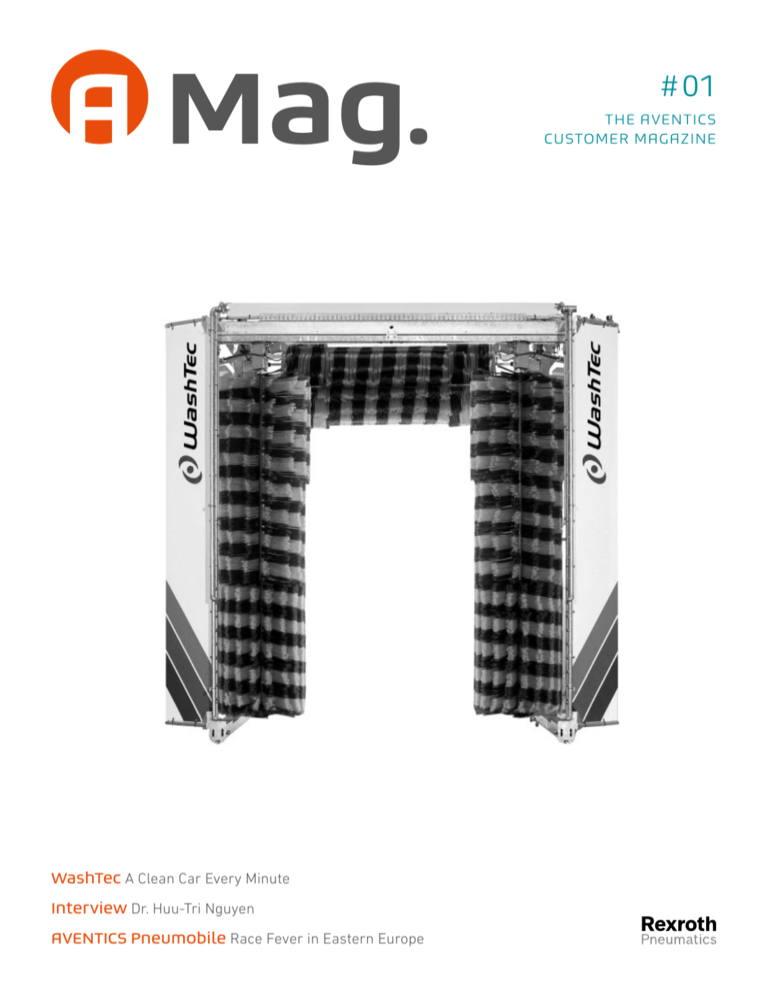
Mag. WashTec A Clean Car Every Minute Interview Dr. Huu-Tri Nguyen AVENTICS Pneumobile Race Fever in Eastern Europe # 01 The AVENTICS customer magazine I mprint Publisher: Head of Marketing: Chief editor: Deputy & editorial staff: Editorial staff: 2 A Mag | AVENTICS GmbH Ulmer Straße 4, 30880 Laatzen, Germany Mirko Pannwitz Tel. +49 511 2136-142 Juliane Maxin Tel. +49 511 2136-870 juliane.maxin@aventics.com Lena Liebenau Tel. +49 511 2136-862 lena.liebenau@aventics.com Torsten Kirchmann Tel. +49 6131 6230 330 info@kirchmann-text.de Photos: Layout: Print: Title page: WashTec AG Others labeled If not labeled: AVENTICS archive Windrich & Sörgel, Agentur für Markenkommunikation Druckhaus Pinkvoss Suggestions, praise, and criticism: amag@aventics.com “Pneumatics is a next generation technology with enormous potential.” Paul Cleaver CEO AVENTICS Welcome to our new AVENTICS magazine, A Mag. AVENTICS, the former subsidiary of Bosch Rexroth, has been operating as a stand-alone company since the start of 2014. AVENTICS, the new company with a long history, is now looking towards the future. From now on, this semiannual magazine will be your regular global information platform on interesting applications, innovations, and technology trends. And A Mag is just like AVENTICS: flexible, uncomplicated, and focused right to the point. At AVENTICS, we concentrate on the huge potential of the next generation of pneumatics. It will continue to be the robust, efficient drive technology for many applications including: machinery, system engineering, commercial, railed vehicles, and maritime applications. This is why AVENTICS will continue developing its products, always working towards the next generation of pneumatics. We are completely focused on increasing the energy efficiency of pneumatics and integrating it seamlessly into digital control systems. A Mag will show you a variety of examples that illustrate how machine manufacturers and users incorporate these new options into their concepts and designs. products are already possible today – with equivalent or even better dynamics. A Mag will demonstrate how you can significantly increase the energy efficiency of your pneumatic solutions with an intelligent system design and thereby reduce lifecycle costs. In addition, this magazine also features reports on marine technology and inverted tooth chains. Right now, I can see a team that is totally committed and driven towards success We will grow together with you, our customers. Enjoy your read, and to excellent business! Yours, Paul Cleaver CEO AVENTICS Energy efficiency plays a crucial role in the future of pneumatics. Contrary to all prejudices, major improvements with series Editorial | A Mag 3 Dear Readers, contents 02 06 10 IMPRINT 03 EDITORIAL 4 A Clean Car Every Minute Plastic valves resistant to jet streams 22 AVENTICS Pneumobile Student competition A Mag | Contents Interview with Dr. Nguyen The future of pneumatics 26 Tipper Tie Tipper Tie sausage packaging Cutting Energy Consumption in Half Adjustable cushioning 28 Kaleidoscope AVENTICS news 16 Ballast Tank System Reliable and cost-efficient 20 Local Across the Globe AVENTICS in China 5 14 30 Tiger Claw Pneumatics offshore Contents | A Mag A clean car every minute Global leader for gantry car washes relies on AV03 6 A Mag | WashTec A Mag Photo: WashTec AG Driving into the wash system, getting out of the car, selecting the program, and watching the gantry move forward and backward: millions use WashTec car wash systems. AVENTICS’ AV03 pneumatic valves are more and more frequently used to ensure sparkling clean vehicles. “We use pneumatics to control chemical-dispensing pumps and to optimally align the washing equipment with the car,” explains Rüdiger Hirschmann, team manager for gantry development at WashTec AG, the leading supplier for vehicle washing solutions around the world, from Augsburg. WashTec controls up to 80 functions using pneumatic valves. These valves need to be highly robust, since they are exposed to jet streams and chemicals in the washing system. “Plastic valves are the only option that we would consider to meet our requirements for shape and function,” Rüdiger Hirschmann emphasizes. The diagonal spool reduces the volume of the Advanced Valves (AV), improving the performance of the supply and exhaust channels. With AV03 valves, AVENTICS has developed the first constructive innovation in valve technology in decades. Decades of experience on the part of AVENTICS went into the development of the new generation with the use of high-performance plastics for pneumatics valves. The result: The high IP65 protection combined with an ergonomic design ensures protection and functionality even in the case of water penetration. “Even the weak points known from other manufacturers where water can penetrate through the LED display after just a few weeks do not exist in the AV03,” says Rüdiger Hirschmann. UP TO 18 WASHES AN HOUR WashTec constructs approximately 1,500 to 2,000 customer-specific gantry washing facilities in different basic configurations each year. The key figure is the number of monthly washes. Selection begins with models for locations with little space and a low washing potential. The SoftCare Pro Classic model pays off after 400 washes a month. The fastest gantry wash system, SoftCare² Juno for top locations with over 1,200 customers monthly, washes and dries up to 18 cars an hour. WashTec offers its gantry wash systems in various equipment variants. “We equip the valve systems to ensure that they are almost always fully loaded,” Rüdiger Hirschmann explains. Each valve block at WashTec is constructed based on logical principles: the “ranking rule” states that valves for emergency off functions are always positioned at the front, followed by anti-frost functions. “As soon as temperatures drop below four degrees, the system needs to be automatically drained to avoid damage from frost,” Rüdiger Hirschmann describes. 7 PROTECTION AND FUNCTION “The AV03 valves present a very refined solution for our environment.” | A Mag Photo: WashTec AG rüdiger Hirschmann, Team manager for gantry development at WashTec AG High product service life – for non-stop clean cars Photo: WashTec AG 8 WashTec constructs approximately 1,500 to 2,000 customer-specific gantry washing facilities in different basic configurations each year. Easy assembly Photo: WashTec AG The efficiency of the valves is particularly advantageous. The coils control very highvolume flows with a low power input. As a result, WashTec does not need additional relays for the coils. “We control our valve systems with a D-SUB 25 plug. This lowers the effort required for assembly significantly,” Rüdiger Hirschmann explains. The valves are designed based on the poka-yoke principle, allowing only correct installation. The technician slides the valve into a hook in the base plate and then only needs to tighten a metal screw from above. “The AV03 valves present a very refined solution for our environment, with an extremely long service life, thanks to their function-specific design and outstanding product quality,” Rüdiger Hirsch­ mann says in summary of his experience with the new valve generation. WashTec by far has the largest basis of over 20,000 gantry wash systems installed worldwide. In addition to gantries, its portfolio also includes conveyor tunnels, selfservice jet wash equipment, commercial vehicle wash systems, water recovery systems, as well as complementary cleaning and care chemicals. In 1962, the founders of WashTec AG submitted a patent application for the world’s first automatic wash system for automobiles. Today, the global leader is present in around 65 countries. AquaX² – maximum filter performance with 70% less energy consumption. A Mag | WashTec WashTec | A Mag Photo: WashTec AG 9 Photo: Markus Hibbeler 10 “Most pneumatic systems could already be much more energy-efficient today.” A Mag | Interview A Mag “Our grandchildren will still be working with pneumatics.” Interview with Dr. Huu-Tri Nguyen, Jade University of Applied Sciences Wilhelmshaven You teach mechatronics and control technology at a German university. For you, what role does pneumatics play in factory automation? Dr. Huu-Tri Nguyen: Pneumatics has its advantages and disadvantages: It can generate linear movements directly, it is fast, it easily meets explosion protection requirements, and it is capable of handling overloads. When it comes to durability, pneumatics also features clear advantages. On the other hand, controllability is a traditional issue, and energy efficiency is not spectacular. But modern pneumatics masters both of these issues. proper system configuration. If I use two 3/2 directional valves paired with an intel­ ligent control instead of a 5/2 directional valve, I lower the compressed air consumption. Cylinder cushioning is another example: cushioning optimized to the application lowers consumption by about 40 to 50 percent. 11 Dr. Huu-Tri Nguyen, born in Vietnam, came to Germany at the age of 18. He studied mechanical engineering and business administration at the University of Aachen. After working in different positions as an engineer, he accepted the offer from Jade University of Applied Sciences in Wilhelms­ haven as a professor of engineering in 1997. His focus is on control technology, mechatronics, hydraulics, and pneumatics. So the energy efficiency of pneumatics systems depends above all on the engineers? Dr. Huu-Tri Nguyen: As engineers, we always tend to stay on the safe side. As a result, we’d prefer to take a 40 mm cylinder, even if a 32 mm cylinder were sufficient. This over-dimension adds up. There are configuration tools that prevent just this. If engineers use these aids consistently, they can increase energy efficiency and design even more compact systems. What are the chances of increasing energy efficiency? Dr. Huu-Tri Nguyen: Most pneumatic systems could already be much more energy-efficient today. It all comes down to Interview | A Mag What do you believe are potential applications for pneumatics in factory automation in the future? Dr. Huu-Tri Nguyen: Everywhere easy and quick movements or metering are required. Take painting systems for the automotive industry for example. In series production, automobile manufacturers change the color for each body. This requires fast pressure and flow metering – and pneumatics is simply the ideal solution. Think of electropneumatic pressure regulators: With plastic blow molding, for example, the process begins with pressures in the millibar range, and ultimately achieves numbers significantly exceeding 10 bar. Engineers look for a suitable solution and integrate the advantages of each tech­ nology. This is why electromechanics and pneumatics will coexist in the future. ments that use ceramic to achieve very long service lives. A number of scientists are working on micro-valves that are etched into silicon together with the electronics. Here, pneumatics can reach nano levels. What innovations do you expect from pneumatics? Dr. Huu-Tri Nguyen: Over the past few decades, we have experienced a switch to plastics, as well as a higher degree of functional integration. Industry continues to advance miniaturization. The smallest pilot valves in the series fit on a 5 cent coin. We are currently seeing interesting develop- Will pneumatics continue to play a role in automation in 2020? Dr. Huu-Tri Nguyen: To be honest, I am certain that even our grandchildren will still be working with pneumatics. What options does control technology offer? Dr. Huu-Tri Nguyen: Fluid technology has strong nonlinearities since compressed air behaves differently than a mechanical wave. But today, the available computing power and memory is more than enough to compensate for this nonlinearity. Modern controls largely offset the disadvantages of pneumatics. What role does pneumatics play for engineering students? Dr. Huu-Tri Nguyen: In many courses, pneumatics is no longer mandatory. The idea is that engineers train the topic in their careers. But pneumatics is more complex than it seems. Intensive involvement with pneumatics quickly reveals that not only pressure and flow, but also thermal science are key. Here, pneumatics manufacturers will have to provide more application support in the future. Photo: Markus Hibbeler 12 “Pneumatics is more complex than it seems. Intensive involvement with pneumatics quickly reveals that not only pressure and flow, but also thermal science are key.” A Mag | Interview 13 Daily searches for the right products, including configuration and documentation, can be time-consuming. AVENTICS Engineering Tools facilitate this process by bundling all necessary tools for pneumatics. Interview | A Mag Adjustable cushioning Cut air consumption in half with a screwdriver Reduce energy consumption by more than 14 50 % With a simple screwdriver alone, machine manufacturers can often lower the energy consumption of pneumatics by more than 50%, while reducing cycle times by up to 40%. The trick: cushioning optimally tailored to the application. “Cushioning prevents the cylinder piston from hitting the cylinder cover or base at uncontrolled speeds,” explains Stefan Krämer, product manager for standard components at AVENTICS. “Uncushioned cylinders strain transported work­ pieces, shorten the service life of the module, and generate vibrations within the entire machine.” Cushioning reduces the piston speed of a cylinder before reaching the final position. There are principally three techniques for cushioning: simple mechanical shock absorption, external shock absorbers, or pneumatic cushioning. External shock absorbers are the most expensive method, which also requires additional space. Mechanical cushioning reduces impact energy only to a limited extent. A Mag | Adjustable cushioning Pre-adjusted solutions are rarely optimal “Pneumatic cushioning is the most sophisticated and efficient solution for most applications,” emphasizes Stefan Krämer. Preadjusted cushioning uses an average value and is therefore rarely optimal. This type of cushioning can only cover a limited range of the possible cushioning capacity and is forced to compromise when it comes to dynamics and precision. If moving masses are too small or speeds too low, overcushioning results. The piston rebounds before reaching the end position due to the excessive air cushion, causing vibrations. The result: increased cycle times and the sensor may accidentally switch. On the other hand, if the masses are too large or the speed is too high, under-cushioning occurs. The insufficient air cushion causes the piston to hit the end position with excessive energy, possibly damaging the cylinder and application. Vibrations also result, which lower the system’s service life and increase noise levels. In this case, the user must use a larger cylinder with higher cushioning capacity to sufficiently cushion the mass or speed. This, however, increases procurement and operating costs. “With adjustable cushioning, much smaller cylinders meet the required performance much better than with pre-adjusted cushioning.” Stefan Krämer, Group Manager Product Management AVENTICS Optimal adjustment cuts air consumption in half 15 By contrast, adjustable cushioning makes optimal use of pneumatic cylinder performance. Adjustments are made via an adjusting screw, which adapts the exhaust duct cross-section. “As a result, much smaller cylinders are able to meet the required performance compared with pre-adjusted cushioning,” states Stefan Krämer. “For example, if a pre-adjusted cylinder with a diameter of 32 mm is used, the engineer can reduce the piston diameter down to 16 millimeters with adjustable cushioning,” he explains. Using a smaller cylinder alone reduces air consumption by around 50%. This also allows users to work with smaller valves, thereby achieving further savings. Tests with higher loads have revealed additional energy-related improvements. The rule of thumb: the more powerful the application, the larger the savings potential. By the way, AVENTICS has expanded its approach beyond the use of ISO cylinders and recently became the first pneumatics manufacturer to offer pneumatic cushioning for mini slides. 75 end position reached % faster Adjustable cushioning cuts air consumption in half and shortens cycle times. Adjustable cushioning not only saves energy, but also reduces cycle times. Only a few turns of the screw are sufficient to ideally adjust the cushioning to the workpiece weight and the dynamics of the movement. According to Stefan Krämer, the results of comparative measurements will get your attention: “Optimally adjusted cushioning shortens braking time by up to 75% compared with pre-adjusted systems. Machine manufacturers can thus cut cycle times by up to 40%.” Adjustable cushioning | A Mag Photo: Getty Images® 16 Pneumatic ballast tank system: keeps ships fit for the high sea Ballast tank systems ensure ship stability and compensate for the load weight. The Marex VCS, a purely pneumatic ballast tank system, provides reliable stabilization, even in the event of a power outage. cargo ca rgo cargo ca rgo ca rgo cargo cargo cargo A Mag | Ballast tank system A Mag cargo 17 Depending on the weight and distribution of the load in the hull, ballast tank systems either flood or empty the distributed tanks. This “trimming” generates counterweights on demand, keeping the ship stable on water. The special challenge: “The system has to continue functioning even in the event of power failure and if the valves are completely submerged,” emphasizes Abdullah Özer, product manager responsible for ballast tank systems. For decades, AVENTICS has equipped ships and offshore facilities with automation solutions and ship controls from the Marex family. The Marex Valve Control System (VCS) ballast tank system has proven itself to be extremely reliable for over 10 years. With the load, the ship sinks deeper into water at one location. Flooding the ballast tanks achieves a stable, horizontal position. Low effort Previously, hydraulic systems were often put to use. “But shipyards would like to reduce tubing effort and system costs,” emphasizes Abdullah Özer. “At the same time, operators more and more often tend towards the environmentally friendly medium air.” Here, pneumatics shows its strengths. Pneumatic tubing and components are significantly cheaper than hydraulic lines. Furthermore, installation is substantially easier since the pressure reaches a maximum of seven bars. “Shipyards have confirmed a cost advantage of around 30% compared with hydraulics,” Abdullah Özer stresses. An additional advantage crucial for operators: The crew can easily service pneumatic systems on the high seas with tools on board. Ballast tank system | A Mag 1 2 3 4 5 18 1 2 3 The Marex VCS pneumatic ballast tank system compensates for the ship’s weight distribution. 4 5 6 6 Air preparation Visualization & automation with Marex AMC Pneumatic control cabinet with control and visualization Backup control with emergency air supply Actuators Tank measuring probe NO POWER REQUIRED The pneumatic actuators of the Marex VCS can be mounted in the tanks and adjust the valves on the ballast tanks without electricity. Pneumatic transmission prevents short circuits in the ballast tanks. An active pneumatic position display, the feedback line, sends the current valve position to the controller without current, ensuring reliable monitoring. Depending on the size of the ship, Marex VCS controls pneumatic switching for up to 100 ballast and quick release valves, including air preparation and all necessary operating and control modules. The standard working pressure is five to seven bars. In the event of a power failure, the crew generates the working pressure via one or more manual pumps, maintaining system function. A Mag | Ballast tank system Mimicked ship movement simplifies operation. “Shipyards have confirmed a cost advantage of around 30% using pneumatics compared with hydraulics.” 19 Abdullah Özer Product Manager Ballast Tank Systems BACKUP IN THE ENGINE CONTROL ROOM EXPLOSIVE ENVIRONMENTS COVERED The ballast tank system can be controlled using the Marex AMC operating and control modules. This automation system is widespread in shipping and allows structured access to all ballast tank system information and functions. Furthermore, it groups and visualizes further systems, such as the engine, the reversing gear system, and additional functions. The modular system communicates with the ballast tank system via CAN bus. It features a self-explanatory touch-screen controller that mimics the ship’s movements and simplifies operation, a major demand in shipping. These purely pneumatic actuators function in a wide range of environments: ballast, bilge, and HFO tanks (heavy fuel oil). For all ships and installations in explosive areas, for example floating oil and gas platforms, the system solution meets ATEX explosion protection requirements. If the main system fails, the valves can be controlled via a backup control and a backup system located outside of the engine control room. This includes one or more manual pumps that ensure function in the event of a power outage. The Marex VCS is certified for use in ships and offshore installations by the world’s leading classification societies. “The system is based on large-scale series components that are available across the globe,” says Abdullah Özer, describing one determining factor. “We are represented with service capacities and spare part warehouses in all major shipping hubs in Europe, Asia, and the Americas.” Ballast tank system | A Mag AVENTICS in China: established as a system supplier China represents the largest market for a wide variety of machines and vehicles. With its predecessor, AVENTICS has been present in the Middle Kingdom since the 1970s, opening a new plant in Changzhou in 2013. On site, AVENTICS also developes tailored, customer-specific solutions. 20 “We are the flexible pneumatics partner for Chinese machine and commercial vehicle manufacturers with many years of experience,” underlines Michel Gunawan, responsible for the Development department at AVENTICS in China. “Our new production plant in Changzhou allows us to quickly respond to customer requirements.” With a current production area of 2,000 m², the company produces both standard cylinders and customer-specific variants, along with complete system solutions with panels, control cabinets, and valve systems. Large contract for Regional Express “Our production meets a European level of quality and we are naturally certified according to ISO 9001,” plant manager Johannes Riechers points out. In particular, he directs his attention to fast lead times and even higher flexibility: “In China, time is critical and that’s our focus.” Colleagues in Changzhou primarily supply the local market. A Mag | AVENTICS in China This convinces customers in China, as a major contract from the rail transport industry currently shows: In the future, AVENTICS rodless cylinders will open and close the doors in Chinese regional express trains. In total, AVENTICS employs over 100 staff in China. Universal, on-site coverage In addition to the production site in Changzhou, AVENTICS operates a series of subsidiaries for sales and service. AVENTICS Trading (Shanghai) Co. Ltd. controls country-wide sales. Additional sales offices in Peking, Dalian, and Changzhou cover the most important industrial centers. 21 Customer talks and feedback from the field are incorporated directly into the AVENTICS portfolio. “We fine-tune the products here on-site based on the requirements of the Chinese market,” emphasizes Michel Gunawan. “We also provide application support and develop tailored, customer-specific solutions.” Customer-specific solutions The components and solutions from AVENTICS are particularly suitable for the rail and industrial vehicle industry, as well as maritime applications and mechanical engineering in general. Developers currently focus on both the textile industry and heavy industries, as well as oil production and processing. Here, AVENTICS has contributed to the first Chinese offshore production assembly as pneumatics partner. The company’s Marine division is also on course for further growth. The components and ship remote controls of the Marex family have established themselves in Europe and are currently finding applications in Chinese shipbuilding. “We respond quickly to customer requirements.” Michel Gunawan, Managing Director AVENTICS in China AVENTICS in China | A Mag A Mag Photo: Getty Images® 22 A Mag | Pneumobile A Mag AVENTICS Pneumobile Race Fever in Eastern Europe 23 For the seventh time, AVENTICS has called for vehicles equipped with purely pneumatic drives in its engineering competition. Student teams from universities across Eastern and Central Europe are invited to participate. This year, 43 teams from five countries took part in the competition. Pneumobile | A Mag A Mag 24 43 teams from 5 nations at the starting line A unique event: the International AVENTICS Pneumobile Competition – Powered by Bosch Rexroth in Hungary. As the main organizer, AVENTICS appeared under its new company name for the first time, while Bosch Rexroth assisted with the event. The teams faced off on the track in downtown Eger in three categories: endurance, agility, and acceleration. A Mag | Pneumobile Industry meet-up sees a Hungarian overall winner 25 The overall winner of the 2014 Pneumobile was the “Kakukktojás” team, Hungarian for cuckoo’s egg, from the Budapest University for Technology and Economics. The students from Hungary’s capital took victory in both the agility and acceleration races. In addition, their vehicle was distinguished as the “Best AVENTICS Pneumobile”. In the distance race, the “Fönix” team from the University of Debrecen, Hungary, demonstrated the most stamina. With a fixed compressed air volume of 10 liters, their vehicle was able to travel 7.77 kilometers. Meanwhile, the event has developed into an industry networking event. Numerous professors, dealers, and pneumatic users from across Eastern and Central Europe took advantage of the weekend in Eger to make new contacts and to exchange information. Preparations for the 2015 International AVENTICS Pneumobile Competition are already underway. Formula-1 atmosphere for the winning teams Pneumobile | A Mag Tasty and hygienic: Tipper Tie sausage packaging Sausage not only has to be tasty, it also has to look tasty and, above all, be produced with top hygiene standards. This is just what the SV4800 clip system from Tipper Tie does with AVENTICS hygienically designed pneumatic components. The SV4800 system forms a wide variety of sausage types. The diameters range from 45 to 160 mm and the system works with a broad spectrum of plastic, fiber, and collagen tube-shaped casings and is highly flexible for all applications. Quick casing changes, different filling density, and reliable U clip technology ensure efficiency, as well as hygienic and, of course, tasty final products. 26 Stainless steel surfaces, excellent accessibility of all areas, a cleaning drawer, a swivel conveyor, and the patented “Easy Clean” stuffing horn ball: the SV4800 leaves nothing to be desired in terms of hygiene. The individual components also meet hygiene requirements from the meat industry. Water tightness and resistance to chemicals are both important factors here. In the system, many of the necessary movements for filling and clipping are performed by pneumatic cylinders. The “Quick Release” – a new swivel mechanism for the casing brake – allows for fast casing change without moving the clip head. The casing brake and stuffing horn are swiveled into the system and locked with an ICM series pneumatic mini cylinder. This stainless steel cylinder series with cylinder covers made of high-quality plastic is extremely resistant to corrosion. In the machine, the tube to be filled is first pulled onto the stuffing horn and then positioned. Next, the system places two clips directly next to each other to close the casing on one side. A cylinder actuates the clip pusher, an overload cylinder actuates the clip tool. The ICS-D2 series overload cylinder is corrosion-resistant and consists of stainless steel. Between the clips, a knife cuts off the first clip. The knife movement to separate the casing is again performed by an ICM cylinder. The clip left on the tube closes it The SV4800 from Tipper Tie: The clip system for slicer ware and shaped products closes plastic, fiber, and collagen casing with diameters up to 160 mm at a rate of up to 120 cycles per minute. A Mag | Tipper Tie AS2: Flow rate up to 2700 l/min, width 52 mm on one side, preparing the casing for filling. Now, actual production can begin – at up to 120 cycles per minute. After filling, the clip tool closes the sausage product. Customers can set different product sizes and lengths. AVENTICS ICM series mini cylinders reliably lock the swivel mechanism. Photo: Tipper Tie Photo: Tipper Tie 27 AVENTICS AS2 series maintenance units prepare the compressed air so that it meets the requirements for use in this state-of-the-art system. The SV4800 is fine-tuned for system sustainability and efficiency right down to the last detail. Tipper Tie | A Mag Kaleidoscope Photo: Getty Images ® Handicrafts for industry 28 Leonardo da Vinci, famous for painting the “Mona Lisa,” also left other entirely different marks. As a technical genius on many levels, he invented a drive based on a chain and sprocket. This idea was finally realized nearly 400 years later. With its predecessor, AVENTICS has been the globally leading producer for inverted tooth chains since 1908. Whether the automotive or glass industry: They all use the silent inverted tooth chains and low-friction, 2-part rolling pivot joint. Production today continues to be a handicraft – coming full circle back to Leonardo. The manufacture of tailored chains is so complicated that the approximately 70 specialists at the AVENTICS plant in Gronau still lay them by hand. AVENTICS on YouTube 52 % New customers The AV valve generation: Achieving new customers Animations and sample system solutions illustrated and events in film: Just enter www.youtube.com/AVENTICS and subscribe to our channel to stay on top of the latest clips. A Mag | Kaleidoscope With the new AV valve generation, AVENTICS is gaining additional market shares. A survey among buyers who purchased the valve showed that 52 percent were new customers. The innovation ideally meets the demand for compact, lightweight valves. With the new diagonal arrangement of the valve spool, the valve systems weigh only half as much as the competitor products available on the market. Every month, customers configure approximately 250 new projects and save their drafts. WIN-WIN: YOUR OPINION COUNTS Win with AVENTICS What do you like about A Mag, what’s missing, what can we improve? We look forward to your suggestions and ideas. Simply send an e-mail to: amag@aventics.com. By the way, this is a clear win-win situation: All customers submitting letters that are received by December 1, 2014, will be entered to win an iPad Air from Apple in Space Gray (32 GB, Wi-Fi). We look forward to your feedback. 29 Eligibility requirements: 18 years and older. Notification of win via e-mail. The organizers’ decision is final. Only one entry per person. AVENTICS employees and persons involved in organizing the raffle are excluded from participation. Cash payment or exchange of the prize is not possible. Participation subject to exclusion if information is incorrect or incomplete, or in case of multiple entries. The winner will be determined by means of a raffle. Participant data is only used in the context of performing the contest. This raffle is being held by AVENTICS GmbH, Laatzen. FIND SPARE PARTS ONLINE Inexpensive spare parts are available for many AVENTICS products. With the new online spare parts catalog at www. aventics.com/spc, visitors can quickly find what they are looking for. The convenient tool includes a wide range of search options: short text, number of the end device, or the material number of the spare part. The spare parts catalog also provides help even if the material number is incomplete. Tip: The spare parts catalog is linked directly to the AVENTCS online catalog; simply click the material number on the data sheet in the online catalog. New Head of Service Klaus Offermann is the new Head of Service at AVENTICS. His extensive experience from his time in various areas at Bosch Rexroth gives him an edge when it comes to drive and control technologies. The 57-year-old is now coordinating the setup and expansion of the global AVENTICS service organization. Kaleidoscope | A Mag Tiger claws for secure drilling Honghua Group Limited is China’s largest exporter of onshore oil and gas drilling equipment. Now, the company has collaborated with the Shanghai Shipyard to develop a new type of drillship. The “Tiger” is designed for bores with depths of 900 to 1,800 meters. Like many projects in the Chinese industrial sector, the main objectives are to keep efficiency up and costs down. Of course, safety is also an important concern. This is just what pneumatics does. As the drill head penetrates new depths, workers keep adding new sections to the pipe above water. Even when the ocean is choppy, the sections cannot move uncontrolled, but must be securely stored at all times. Like the claws of a tiger, pneumatically actuated clamping fingers maintain a secure grip on the pipe sections, even in stormy weather. Approximately 350 seawater-resistant pneumatic cylinders A Mag | Tiger claws “The wide spectrum of electrically actuated valves from AVENTICS provides support for numerous communications protocols,” explains sales engineer Lin Hao, who supervises the project at AVENTICS in China. “Honghua was able to implement a highly flexible and efficient solution using fieldbus technology.” To ensure that the seawater-resistant cylinders can supply the necessary force, AVENTICS adapted them for the specific requirements of the project. The expertise was acquired through decades of experience in outfitting deep-sea vessels. “With the Tiger project, we have once again proven that we are the leading systems supplier for tailored offshore pneumatics solutions in China,” Lin Hao states confidently. Photo: BP Plc. Photo: Getty Images ® 30 Requires special safety precautions: assembling drilling pipes on ships. actuate these claws to hold sections that are stored on deck. Working from the cabin, the crew leader in the tower releases the sections one by one and grips the new sections. The related commands are transmitted via fieldbus to the pneumatic valves in two control cabinets, which then move the cylinders. The first offshore drillship from China with pneumatics from AVENTICS. 31 BE INSPIRED BY the Next Generation Pneumatics In the future, rely on experts from AVENTICS. With premium products from our Pneumatics, Marine, Inverted Tooth Chain, and Truck divisions, we are continuing our success story under our own name in 2014. AVENTICS is synonymous with fresh ideas, great flexibility, and a maximum focus on you – our customers. AVENTICS GmbH Ulmer Straße 4 30880 Laatzen, Germany www.aventics.com | A Mag AVENTICS GmbH Corporate Communications Ulmer Straße 4 30880 Laatzen, Germany www.aventics.com info@aventics.com Further contacts: www.aventics.com/contact Subject to change. Printed in Germany. © This document, as well as the data, specifications and other information set forth in it, are the exclusive property of AVENTICS GmbH. It may not be reproduced or given to third parties without its consent.
